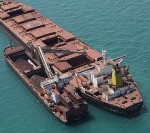Centrex leaning towards transhipment for Port Spencer
Centrex Minerals is likely to choose transhipment over a deepwater jetty at its Port Spencer export project in South Australia, chief executive Ben Hammond has told AJM.
After initially planning to build a 500m jetty and shiploader out to water deep enough to handle a large bulk carrier, Centrex had a re-think in November last year when it commissioned a Parsons Brinkerhoff study to investigate a transhipment option.

Centrex is leaning towards CSL’s new transhipment method, shown here, at Port Spencer in South Australia.
Under a transhipment model, a jetty would not need to go out to as deep an area, and smaller vessels would tranship bulk material between the jetty and a large bulk carrier, which would be anchored in deepwater.
Following the study in November, Centrex did say that the transhipment idea would be a cheaper option, but did not suggest that it was leaning either way on the decision between it and the original, deepwater plan.
But now, Centrex is close to officially deciding on the cheaper, transhipment model, chief executive Ben Hammond has told AJM.
“It’s likely we’ll go ahead with the transhipment option,” Hammond said last week. “It’s more cost effective.
“It reduces the capital by about half. Not only that, but the operating costs are staying reasonably similar to direct loading.”
On top of the start-up cost factor, Hammond said the transhipment option made the port project a more viable one in an operational sense.
“Just one project can justify the port,” he said. “Rather than needing two of our mines to justify the port, now a single project can mean the port can still produce a good infrastructure return, operating as its own company … You can go ahead with a [deepwater] port, but the mine’s subsidising the port … through this new design, the port – as its own business – is making a good return, charging the mine a reasonable rate.”
While there is no contract in place between Centrex and shipping business CSL – which runs Arrium’s transhipping operation out of Whyalla to the north of Port Spencer – Hammond said the mining company is working with CSL while it plans its next steps.
“We’re not contracting anyone at the moment, but we’ve certainly been working in conjunction with CSL to this point. I’m aware of other companies starting to look at similar systems, [but] the advantage of CSL is they’ve already been operating up the road [at Whyalla] and there’s synergies with these vessels being shared between ports.”
CSL’s new transhipper technology comprises a self-powered, self-docking vessel, replacing the traditional barge and tug arrangements, and also eliminates the need for tug facilities.
“Under the new design option the transhipper would load cape-class vessels anchored approximately one nautical mile offshore in a water depth of about 23m,” Centrex said in a November 2013 ASX release.
“This depth would also allow consideration in the future for larger vessel sizes if warranted. The transhipper would also be capable of loading smaller Panamax-class vessels required for grain exports.”
Centrex hopes to build the Port Spencer export facility to support a number of its projects in the region.
Its Fusion project, under the Eyre Iron magnetite joint venture with Wuhan Iron & Steel, is currently in its feasibility stage, and would ideally move product 40km by slurry pipeline to Port Spencer.
The Bungalow magnetite project, a joint venture with Baotou Iron & Steel Group, also in its feasibility stage, would use a 100km slurry pipeline to export from Port Spencer.
Meanwhile, Centrex’s wholly owned hematite project, Wilgerup, yet another project in its feasibility stage, would transport product by road, 110km to the port.
“The thing with these new transhipment designs, it’s a better solution because you’re never going to be able to build a single port that’s optimal to everyone,” Hammond continued.
“It’s a good thing that occurs in South Australia – everyone’s so close to the coast. When you’re all 600km inland there’s a common corridor, but when you’re all so close to the coastline, the transhipment’s going to allow single projects to justify ports.”
Source from here
